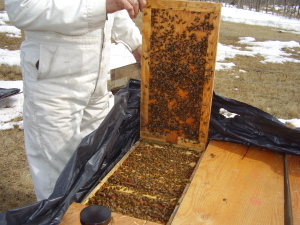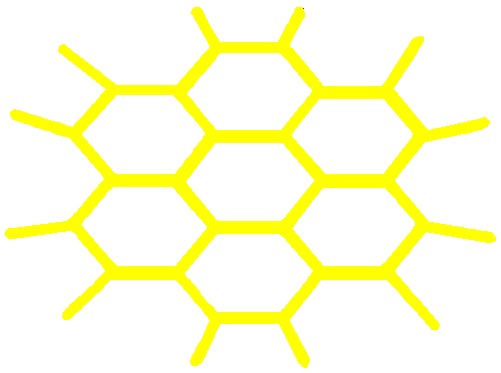WINTERING MATING NUCS
 During the winter of
2007 - 2008 we experimented wintering 16 hives on mating nuc combs.
The purpose was to see if we could start stronger mating nucs earlier in the
spring from over-wintered
bees reducing the need to rob bees from
our main hives. It also would provide a way to bring more queens
through the winter with which to requeen hives in the spring. Finally,
it was an easy way to close out our mating nucs from the summer.
During the winter of
2007 - 2008 we experimented wintering 16 hives on mating nuc combs.
The purpose was to see if we could start stronger mating nucs earlier in the
spring from over-wintered
bees reducing the need to rob bees from
our main hives. It also would provide a way to bring more queens
through the winter with which to requeen hives in the spring. Finally,
it was an easy way to close out our mating nucs from the summer.
Five of our mating nucs combs fit into a compartment 235 mm long x 205
mm wide x 140 mm deep. Those five combs comprise a mating nuc that
we refer to as a “baby nuc”. To make up a mating nuc hive we used
4 shallow baby nuc supers filled with 12 combs each on a bottom board.
We wrapped them in packs of eight and covered them with snow as soon as
there was enough snow to do it.
We were extremely pleased with the initial results. In the spring, of
those 16 hives, 2 hives were dead, 1 hive was queenless, and 1 hive was weak.
We lost the weak hive during a snow storm. Therefore the winter loss
was 25%. We initially used the bees from the queenless hive to boost the
other 12 hives and then broke up those 12 hives to start smaller mating mating
nucs with brood. As we hoped, our mating nucs were stronger requiring
significantly less boosting from our regular hives.
We put 48 of these mating nuc
hives into winter in the fall of 2008. We
ended up with 44 viable mating nuc hives in the spring. Again we
were quite pleased with a loss rate of about 8%.
In the fall of 2009 we put 72
mating nuc hives into the winter. However, we were expecting a high
winter loss rate. With the oddness of the fall, our management was
poor. We know that the mating nuc hives were poorly fed and did not
entering the winter in top condition. As well, we did not treat them in
any way for varroa mites. To see if it was possible, about 1/3 of
them were wintered in 3 storeys instead of 4. In the end, we were left
with 59, an 18% loss which was significantly better
than the rest of our hives. We could see no difference between
the survival rate between the 4 storey vs. the 3 storey hives. In
2010, these hives helped us both get a honey crop and make new hives.
We stripped these hives repeatedly in the spring to start mating nucs,
saving our few strong hives to start cells and for honey production.
In 2010 we experimented by putting
more 3 storey mating nuc hives into winter. Like normal hives these
are nicer to work, if there are fewer storeys and therefore fewer combs,
to find the queen on or to clean. Additionally, if we can winter them
in fewer storeys, we can potentially winter more, which would bring more
queens through the winter to requeen the normal hives. By 2011, we
wintered all of our mating nuc hives as 3 stories. By the spring of 2013, we had
successfully wintered these mating nucs for 6 years and decided that these hives were a part of our normal beekeeping practice and are no longer
experimental.
Then in the spring of
2014, not one survived the winter. What happened? What did
we do different? We still haven't figured it out. We have
figured out that these hives require more care in the spring,
particularly spring feed. The combs are only 140 mm deep and yet
the bees will not bridge the gap and go down to the next super for
feed. It has reemphasized why we run singles in our normal
operations. We continue to overwinter these and use them to rob
brood and bees from to start mating nucs. We are still learning
what is the most effective way to run them to rob from them. We
are trying to run as few as possible.
Perhaps, what has really
distracted us from trying to perfect this method of wintering is that
we are actually now working on overwintering actual mating nucs.
Baby
nuc hives are a benefit to rob mating nuc brood from in the spring and
useful to close out mating nucs in the fall, but otherwise they are a
pain with too many combs and needing more feed because of those extra
layers.
|
top
Revised: February 1, 2018.
Copyright © 2002 Pedersen Apiaries. All
rights reserved.
Original Design & Graphics by Karen Pedersen
Photographic images are under copyright and
used with permission of John Pedersen or Karen Pedersen
|
 During the winter of
2007 - 2008 we experimented wintering 16 hives on mating nuc combs.
The purpose was to see if we could start stronger mating nucs earlier in the
spring from over-wintered
bees reducing the need to rob bees from
our main hives. It also would provide a way to bring more queens
through the winter with which to requeen hives in the spring. Finally,
it was an easy way to close out our mating nucs from the summer.
During the winter of
2007 - 2008 we experimented wintering 16 hives on mating nuc combs.
The purpose was to see if we could start stronger mating nucs earlier in the
spring from over-wintered
bees reducing the need to rob bees from
our main hives. It also would provide a way to bring more queens
through the winter with which to requeen hives in the spring. Finally,
it was an easy way to close out our mating nucs from the summer. 